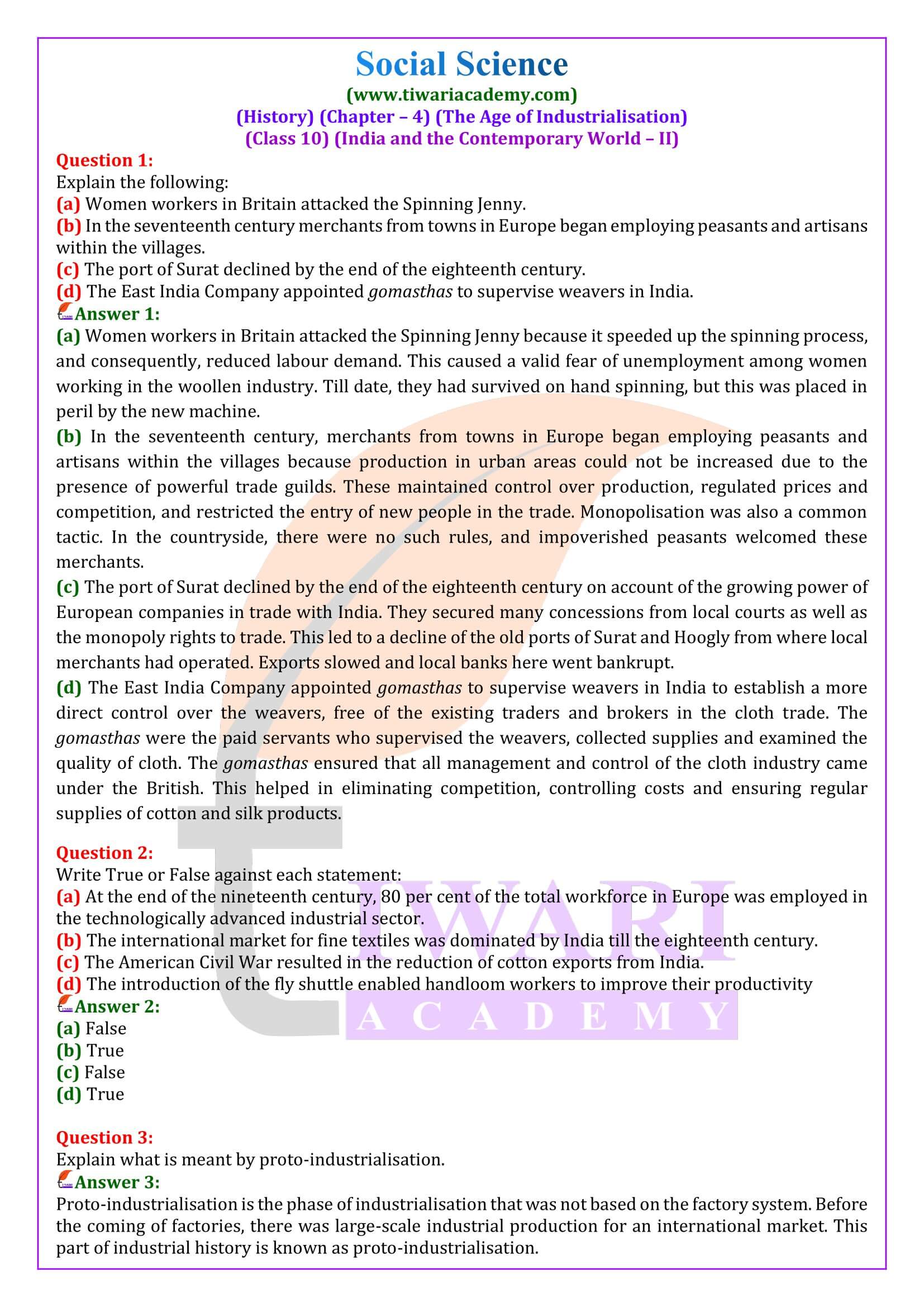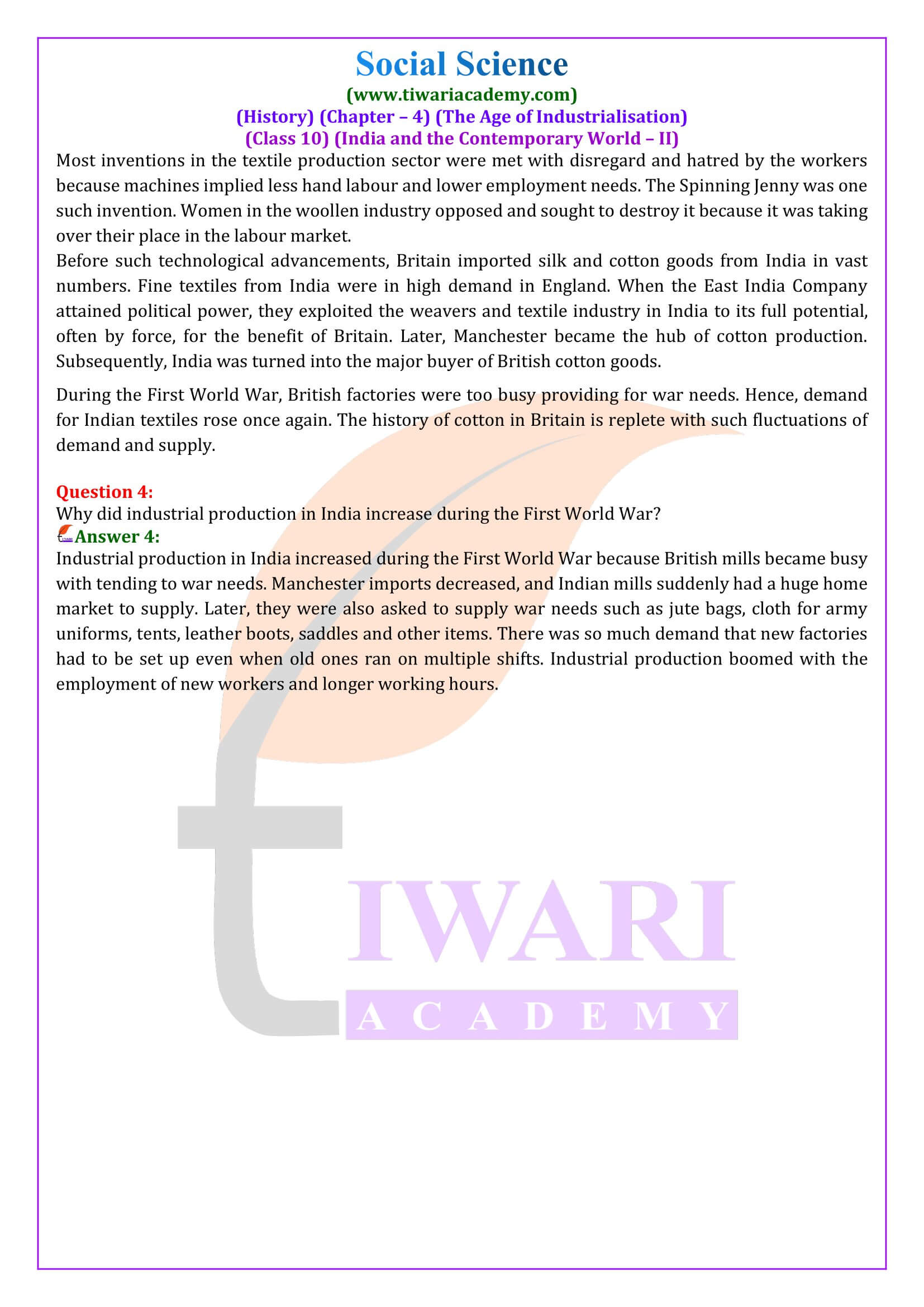NCERT Solutions for Class 10 History Chapter 4 The Age of Industrialisation in Hindi and English Meidum for academic session 2025-26 UP Board, MP Board, CBSE and other boards who are using NCERT Books. Visit to discussion forum to share your knowledge with your friends and other users of Tiwari Academy. There are so many important questions are also uploaded for CBSE Board exam preparation. These questions are given at the end of this page.
NCERT Solutions for Class 10 History Chapter 4
NCERT Solutions for Class 10 History Chapter 4
| Class: | 10 |
| Subject: | Social Science – History |
| Chapter 4: | The Age of Industrialisation |
| Session: | 2025-26 |
NCERT Solutions for Class 10 History Chapter 4 in PDF
Class 10 History Chapter 4 The Age of Industrialisation questions answers are given below to free download in PDF form. NCERT Solutions and Apps are updated for new academic session 2025-26 based on new NCERT Books following the latest CBSE Syllabus.
Exatra Questions Class 10 History Chapter 4
Who were Jobbers? What was their role?
Jobbers were kept for recruitment. Jobber was generally an old confident. He used to bring people from villages.
Why new industrialist could not displace traditional industries?
1. Number of people working in industries was less.
2. Slow changes in technology.
3. Cloth industry was dynamic
4. Technology was expensive.
5. A large part of production was done in Handlooms
What is meant by Capital?
It is the part of money which is invested for trade purpose.
What is Staples?
A person who ‘Staples’ or sorts wool according to fibre.
What is Fuller?
Fuller is a person who ‘Fulls’ that it gathers cloth by pleating.
What is meant by Carding?
The process in when fibres such as cotton or wool are prepared prior to spinning.
Years of Events
1600: The East India company was established.
1760: Britian imported New cotton to feed its cotton industry.
1781: James watt improvised steam engine & patented it.
1840: Cotton was the leading sector in the first phase of Industrialisation in Britain.
1854: The first cotton mill was established in Bombay.
1855: The first Jute Mill was set up in Bengal.
1860: Elgin Mill was started in Kanpur.
1861: The first cotton mill was setup in Ahmedabad.
1874: The first spinning & weaving mill & Madras began its production.
1912: J.N. Tata set up first Iron & Steel works in Jameshedpur.
1917: Seth Hukumchand set up first Jute Mill in Calcutta.
Multiple Choice Questions – MCQ
1. Who invented steam engine
(a) James Watt
(b) New Comen
(c) Richard Arpwright
(d) E.T. Paull
2. Who were Jobbers?
(a) A person employed by industrialist to new recruits
(b) A paid servant of East India company
(c) A person employed by farmer to sell their products
(d) A person doing most important job in a factory
3. Dwarkanath Tagore was a ___________
(a) Indusrialist
(b) Painter
(c) Philosopher
(d) Social Reformer
4. When did the exports of British cotton increase dramatically?
(a) In the early 17th century
(b) In the early 18 century
(c) In early 19 century
(d) In early 20 century
5. Which of the following were the most dynamic industries of the Great Britain?
(a) Cotton and Metal Industry
(b) Metal & Agrobased industries
(c) Cotton and Sugar Industry
(d) Ship & Cotton
Answers to MCQ
1. (a)
2. (a)
3. (a)
4. (c)
5. (a)
One Mark Questions with Answers
1. In the 19th industrialist in which country started using machines.
2. Name two most important industries of Europe?
3. In which decade factories opened in England?
4. Why industrialist was reluctant to use machines?
5. Who were Gomashtas?
6. In the initial phase of Industrialisation.
7. What kind of products introduced European Managing Agencies?
8. How did spinning Jenny accelerated production?
9. How do Urban producers control production?
10. Which methods were adopted to create new consumers?
Important Questions on Class 10 History Chapter 4
Women workers in Britain attacked the Spinning Jenny. Why?
Women workers in Britain attacked the Spinning Jenny because it speeded up the spinning process, and consequently, reduced labour demand. This caused a valid fear of unemployment among women working in the woollen industry. Till date, they had survived on hand spinning, but this was placed in peril by the new machine.
In the seventeenth century merchants from towns in Europe began employing peasants and artisans within the villages.
In the seventeenth century, merchants from towns in Europe began employing peasants and artisans within the villages because production in urban areas could not be increased due to the presence of powerful trade guilds. These maintained control over production, regulated prices and competition, and restricted the entry of new people in the trade. Monopolisation was also a common tactic. In the countryside, there were no such rules, and impoverished peasants welcomed these merchants.
The port of Surat declined by the end of the eighteenth century. Give reason?
The port of Surat declined by the end of the eighteenth century on account of the growing power of European companies in trade with India. They secured many concessions from local courts as well as the monopoly rights to trade. This led to a decline of the old ports of Surat and Hoogly from where local merchants had operated. Exports slowed and local banks here went bankrupt.
The East India Company appointed gomasthas to supervise weavers in India. Why?
The East India Company appointed gomasthas to supervise weavers in India to establish a more direct control over the weavers, free of the existing traders and brokers in the cloth trade. The gomasthas were the paid servants who supervised the weavers, collected supplies and examined the quality of cloth. The gomasthas ensured that all management and control of the cloth industry came under the British. This helped in eliminating competition, controlling costs and ensuring regular supplies of cotton and silk products.
Explain what is meant by proto-industrialisation.
Proto-industrialisation is the phase of industrialisation that was not based on the factory system. Before the coming of factories, there was large-scale industrial production for an international market. This part of industrial history is known as proto-industrialisation.
Why did some industrialists in nineteenth-century Europe prefer hand labour over machines?
Some industrialists in nineteenth-century England preferred hand labour over machines because there was no labour shortage in the market, and as a result, there was no problem of high wage costs either. Industrialists did not wish to replace hand labour with machines that would require large capital investment. Also, in industries where the production and amount of labour required were dependent on the seasons, hand labour was preferred for its lower costs. Apart from this, many goods could only be manufactured by hand. Machines could provide mass quantities of a uniform product. But the demand was for intricate designs and shapes; this required human skill, and not mechanical technology. Handmade products also stood for refinement and class status. It was commonly believed that machine-made goods were for export to the colonies.
How did the East India Company procure regular supplies of cotton and silk textiles from Indian weavers?
After establishing political power, the East India Company successfully procured regular supplies of cotton and silk textiles from Indian weavers via a series of actions. These actions were aimed at eliminating competition from other colonial powers, controlling costs and ensuring regular supplies of cotton and silk goods for Britain. Firstly, it appointed gomasthas or paid servants to supervise weavers, collect supplies and examine textile quality. Secondly, it disallowed Company weavers from dealing with other buyers. This was ascertained by a system of giving advances to the weavers for procuring raw materials. Those who took these loans could not sell their cloth to anyone but the gomasthas.
Why did industrial production in India increase during the First World War?
Industrial production in India increased during the First World War because British mills became busy with tending to war needs. Manchester imports decreased, and Indian mills suddenly had a huge home market to supply. Later, they were also asked to supply war needs such as jute bags, cloth for army uniforms, tents, leather boots, saddles and other items. There was so much demand that new factories had to be set up even when old ones ran on multiple shifts. Industrial production boomed with the employment of new workers and longer working hours.
Answers of 1 Mark Questions
1. USA
2. Cotton and steel industry
3. In 1730s.
4. Cheap Human Labour – Avail ability
5. Supervisor appointed by East India Company over Weavers.
6. Cotton and Metal Industries
7. Plantation – Tea and Coffee
8. Spinning
9. Merchants used to give loans to Artisans
10. Through advertisements






